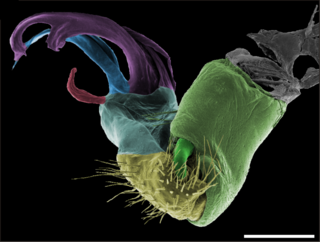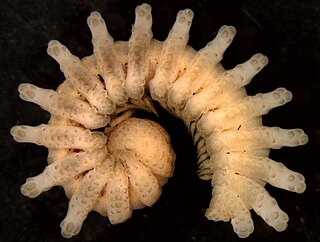
Millipedes are a group of arthropods that are characterised by having two pairs of jointed legs on most body segments; they are known scientifically as the class Diplopoda, the name derived from this feature. Each double-legged segment is a result of two single segments fused together. Most millipedes have very elongated cylindrical or flattened bodies with more than 20 segments, while pill millipedes are shorter and can roll into a tight ball. Although the name "millipede" derives from Latin for "thousand feet", no species was known to have 1,000 or more until the discovery in 2020 of Eumillipes persephone, which can have over 1,300 legs. There are approximately 12,000 named species classified into 16 orders and around 140 families, making Diplopoda the largest class of myriapods, an arthropod group which also includes centipedes and other multi-legged creatures.

Gonopods are specialized appendages of various arthropods used in reproduction or egg-laying. In males, they facilitate the transfer of sperm from male to female during mating, and thus are a type of intromittent organ. In crustaceans and millipedes, gonopods are modified walking or swimming legs. Gonopods may be highly decorated with elaborate structures which may play roles in sperm competition, and can be used to differentiate and identify closely related species. Gonopods generally occur in one or more pairs, as opposed to the single (un-paired) reproductive organs such as the aedeagus of insects or the penis of harvestmen.

Spirobolida is an order of "round-backed" millipedes containing approximately 500 species in 12 families. Its members are distinguished by the presence of a "pronounced suture that runs "vertically down the front of the head". Most of the species live in the tropics, and many are brightly coloured. Mature males have two pairs of modified legs, the gonopods, consisting of the 8th and 9th leg pair: the posterior gonopods are used in sperm-transfer while the anterior gonopods are fused into a single plate-like structure.

Polydesmida is the largest order of millipedes, with more than 5,000 species, including all the millipedes reported to produce hydrogen cyanide (HCN). This order is also the most diverse of the millipede orders in terms of morphology. Millipedes in this order are found in all regions of the world other than Antarctica.

Polyzoniida is an order of millipedes in the subterclass Colobognatha. This order contains three families and more than 70 described species. The species in this order are also known as camphor millipedes, because ozopore secretions in this order frequently have a strong camphor-like smell. Poison frogs in South America and Madagascar evidently obtain some of their poison from these millipedes.

Chordeumatida is a large order of millipedes containing more than 1,400 species. Also known as sausage millipedes, they are found nearly worldwide. Chordeumatida is the largest order in the superorder Nematophora, a group also known as spinning millipedes because their telsons feature spinnerets used to build nests of silk. These millipedes produce this silk to create chambers in which to molt or to lay their eggs.
Branneria is a genus of small millipedes in the order Chordeumatida and the only genus in the family Branneriidae. Individuals reach about 4 mm (0.16 in) long. There are two species known, found in the southeastern USA: Branneria bonoculus is found in Arkansas and eastern Texas while B. carinata occurs from North Carolina to Florida and Mississippi. The adult B. bonoculus millipede has 28 body segments, and the adult B. carinata millipede has 26, both fewer than the 30 usually found in the order Chordeumatida. In both species, the gonopod complex in adult males includes three leg pairs rather than just the two that are usually modified into gonopods in this order.

Siphoniulus is a poorly known genus of millipede containing only two living species: S. alba from Indonesia, and S. neotropicus from Mexico and Guatemala. An additional two fossil species are known from Cretaceous amber. Siphoniulus species are the only members of the family Siphoniulidae and order Siphoniulida, making Siphoniulida the smallest millipede order. Few specimens are known, and their classification is contentious, although most recent studies place them as basal members of the Helminthomorpha.

Haplodesmidae is a family of millipedes in the order Polydesmida. This family includes about 70 species. Species occur in East Asia, Southeast Asia, and Oceania, although some species have been introduced to the New world tropics.

Metopidiotrichidae is a family of millipedes in the order Chordeumatida. This family includes more than 70 species. These millipedes are found in Indochina, Australia, and on Pacific islands from New Zealand to Japan.
Chordeumatidae is a family of millipedes belonging to the order Chordeumatida. These millipedes range from 7 mm to 18 mm in length and are found in Europe. Adult millipedes in this family have either 28 or 30 segments. This family features distinctive sex-linked modifications to the legs in adults: In the adult female, a legless sternite replaces the third pair of legs, and in the adult male, five pairs of legs are modified in the gonopod complex. These modifications are more extensive than those found in other adult males in this order, which often have only two leg pairs modified into gonopods. With the more extensive modifications to the legs in this family, species with the usual 30 segments feature adult females with only 49 leg pairs and adult males with only 45 pairs of walking legs, and species with only 28 segments feature adult females with only 45 leg pairs and adult males with only 41 pairs of walking legs.
Speophilosomatidae is a family of millipedes belonging to the order Chordeumatida. These millipedes are found in Japan and range from 4 mm to 6 mm in length. Adult millipedes in this family are notable for being among the few in this order with only 26 segments instead of the 30 usually found in chordeumatidans. The adult males in this family are also notable for involving three leg pairs in the gonopod complex rather than the two pairs typically modified into gonopods in this order.
Peterjohnsiidae is a small family of millipedes belonging to the order Chordeumatida. The family was first described in 1987 by Jean-Paul Mauriès. These millipedes range from 3 mm to 8 mm in length and are found in Australia. Species in this family exhibit sexual dimorphism in segment number: adult males have 30 segments, but adult females have 32 segments. In adult males in this family, the gonopod complex involves three leg pairs rather than just the two usually modified into gonopods in this order.
Hoffmaneumatidae is a family of millipedes belonging to the order Chordeumatida. This family includes two genera, one (Hoffmaneuma) found in the Russian Far East and the other (Japanoparvus) found in Japan. Millipedes in this family range from 4 mm to 6 mm in length. Adult millipedes in this family have only 28 segments, not the 30 segments usually found in this order. Adult males in this family feature a reduced leg pair 10 in addition to the two pairs normally modified into gonopods in this order. In the adult male of the species Hoffmaneuma exiguum, for example, the gonopod complex derives from all three leg pairs rather than from just the usual two.
Lipseuma is a genus of millipedes in the family Kashmireumatidae. This genus contains only two species, the type species L. josianae and its close relative L. bernardi. Both species are troglobites found in caves in China.
Tianella is a genus of millipedes in the family Entomobielziidae. This genus includes eleven species found in Nepal, one species found in Kazakhstan, and one species found in Kyrgyzstan. This genus is notable for including the only species in the order Chordeumatida with 29 segments in adults. Most species in this genus have 29 segments in adults rather than the 30 segments usually observed in this order.
Metamastigophorophyllon is a genus of millipedes in the family Anthroleucosomatidae. This genus includes millipedes found in Azerbaijan, Iran, Russia, and Georgia. All five species in this genus have 31 segments in adults. This genus is notable for including the only species in the order Chordeumatida with 31 segments rather than the 30 segments usually observed in adults in this order.
Neocambrisoma is a genus of millipedes in the family Metopidiotrichidae. Millipedes in this genus are found in Tasmania and New South Wales in Australia. Like other genera in this family, this genus features 32 segments in adults of both sexes, rather than the 30 segments usually observed in adults in the order Chordeumatida. Accordingly, female adults in this genus have 54 pairs of legs, which is not only the maximum number observed in this order but also the maximum number fixed by species in the class Diplopoda.
Neocambrisoma raveni is a species of millipede in the family Metopidiotrichidae. These millipedes are found in New South Wales in Australia. Like other species in this family, N. raveni features 32 segments in adults of both sexes, rather than the 30 segments usually observed in adults in the order Chordeumatida. Accordingly, adult females of this species have 54 pairs of legs, which is not only the maximum number observed in this order but also the maximum number fixed by species in the class Diplopoda.
Agenodesmus reticulatus is a species of millipede in the family Fuhrmannodesmidae, which some authorities consider a junior synonym of Trichopolydesmidae. This millipede is among the very few species in the order Polydesmida to feature adults with only 18 segments rather than the 20 segments usually found in this order. This species is notable as the first polydesmidan millipede discovered with only 18 segments in adults, the smallest number recorded in the order Polydesmida. Before the discovery of A. reticulatus, polydesmidans were known to have only 19 or 20 segments in adults.








